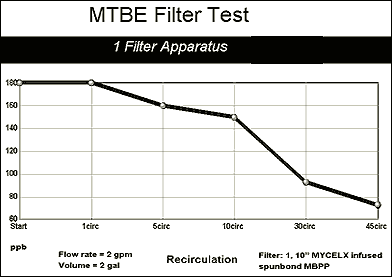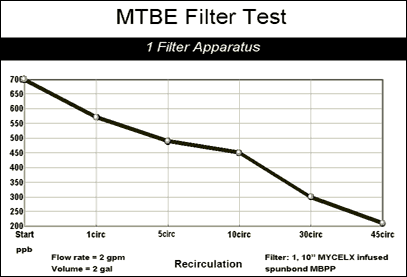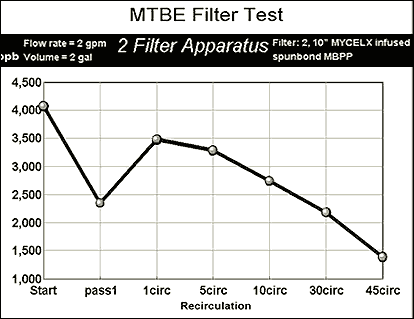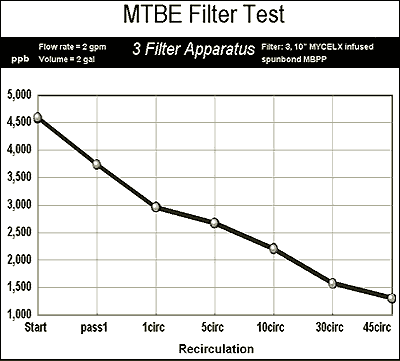New Chemistry Process Looks Promising for MTBE Removal
Since its discovery a few years ago, the wastewater treatment chemistry process known as MYCELX has undergone rigorous testing against a wide range of toxic pollutants as well as within a diverse group of industrial operations.
It was only a matter of time before this testing would target the drinking-water contaminant methyl tertiary butyl ether, or MTBE. To date, the results of initial testing have been promising with an up to 30% first-pass efficiency as compared to approximately 5% first-pass efficiency for activated carbon filters. Further advancements are expected as additional refinements are made to this chemistry process developed by MYCELX Technologies (MES) of Gainesville, Georgia.
With the lack of a regulatory impetus for MTBE removal due to relatively new awareness of this compound's potential environmental dangers, it has been difficult for the developer to initiate field trials. However, initial independent lab testing shows that this chemistry surpasses common environmental technologies such as activated carbon, air strippers and bioremediation. The primary reason for this finding is that the MTBE release rate—as opposed to the absorption rate—is lower with MYCELX-infused filters.
This new chemistry, which has its origin in the oil-remediation arena, is actually a solubilization reaction that makes contaminants more soluble within it (relative to the medium in which it is used), thereby affecting their removal from water. Because the molecular structure of this chemistry is complementary to methyl tertiary butyl ether, it has a particularly high affinity for MTBE—or at least greater than other currently-available removal technologies.
A Micelle Magnet
MYCELX is not a product. It is a chemistry, a new class of molecular compounds with the ability to remove the entire range of organic chemicals from various industrial wastewater processes. In its natural state, the compound is a clear, non-toxic solid chemical. However, it can be transformed into a liquid with various thicknesses, depending upon its specific application need.
This chemistry possesses similar traits of surfactants though it is much different. It works by forming a complex network of molecules that, among other things, causes organic molecules to form micelle structures—hence the name MYCELX. These micelles are extremely hydrophobic; it is this property that is key in the chemistry's ability to grab and remove organic compounds regardless of size, shape and degree of water solubility from waste streams. However, whether water soluble or insoluble, materials coated with this chemistry instantly bond organic compounds to their surfaces and prevent them from separating and emulsifying.
The Problem with MTBE
To date, the difficulty in effective MTBE removal has been its relatively high water solubility. Due to it being an ether, MTBE possesses an oxygen molecule that leads to hydrogen bonding. Conversely, other hydrocarbons such as pentane do not carry the oxygen molecule, thus they are not as water soluble as their polar equivalents.
Activated Carbon Treatment
With activated-carbon treatment, MTBE initially is adsorbed from water onto the surface of the carbon, but then nearly all but a small percentage is released back to the water. Why? Carbon and water have very similar affinities for MTBE; therefore, MTBE's adsorption rate is close to its dissolution rate. In other words, the molecular-sized holes of the carbon filter grab the MTBE on the surface but then release most of the substance back to the water. In comparison, MTBE dissolves more readily into a substrate filter infused with MYCELX, as evidenced by test results. MTBE has a much higher affinity for this polymer; thus, the release rate is much less.
Air Strippers
Air strippers perform best on compounds with high vapor pressure and low water solubility. Because MTBE is just the opposite (relatively low volatility and high water solubility), air strippers perform inefficiently and are relatively costly for MTBE removal. In addition, the air-stripper process merely discharges the MTBE back into the air where it potentially will re-condense or contribute to the formation of urban smog. An attempt has been made to overcome this handicap with the addition of air scrubbers; however, while the MTBE may dissolve into the scrubber media, the process—which adds more expense and thermodynamic inefficiency—still does not remove it. Overall, air strippers are losing favor in certain environmental circles and may soon face a phase-out under future EPA action.
Bioremediation
As for the bioremediation process, it must work under the restraints of site-controlled conditions. The microbes are not "robust enough" to thrive in an uncontrolled environment such as ground water and still produce acceptable digestion rates.
MYCELX Testing
The developer's initial internal testing of the process with MTBE demonstrated enough potential to warrant an independent, external lab analysis. Analytical Services Inc., a testing lab in Norcross, GA, conducted the test (EPA method 8260B) with 10-inch 5-micron spun-bound polypropylene filters infused with this chemistry compound to a weight ratio of 20% w/w wt. (MYCELX)/wt. (MYCELX + substrate). These filters were tested against a control group of untreated filters. The filters were placed in a filter cartridge attached to a recirculating assembly (Figure 1).
Figure 1

The flow rate through the assembly was 2 gpm. Total water volume was two gallons. Initial concentration of MTBE was 180ppb (Figure 2) and 700ppb (Figure 3). Temperature was ambient. Two filters and 3 filters in series also were tested in the same manner. MES technicians analyzed parallel samples utilizing SRI Gas Chromatograph 8610.
Figure 2

Figure 3

The control tests performed on untreated filters showed no significant MTBE removal. However, the analysis (Figures 4 and 5) indicated approximately 50% reduction in MTBE values with the two-filter unit within 30 minutes of recirculation. With the three-filter unit, the results increased to 65% removal.
Figure 4

Figure 5

It appears that an equilibrium is established between capture of the MTBE and its dissolution. The equilibrium constant (Keq) appears to be independent of exposure time and, as expected, higher initial MTBE concentrations seem to push the equilibrium in favor of capture.
A Viable Tool for MTBE Removal
For organic compounds such as PCBs, aromatic hydrocarbons and oils, the MYCELX chemistry usually demonstrates single-pass efficiency in excess of 98% using comparable numbers and testing as performed in the MTBE test. The single-pass efficiencies for MTBE seem to be in the range of 10% to 30%, relatively independent of filter configuration and residence time. The efficiency after 45 minutes is in the range of 70% and comprises approximately 20 to 40 recirculations through the filter. This indicates that the equilibrium constant between adsorption and dissolution for MTBE with the MYCELX filter—which is two to three orders of magnitude better under similar conditions for granular activated carbon—could still be improved utilizing this chemistry with higher hydrophilic to lipophilic balance (HLB).
However, the developer believes that the current generation of this technology is the only viable tool for removal of MTBEs from aqueous streams and that it could be deployed effectively with proper engineering modifications. Field tests already are being conducted utilizing 30-inch cartridge units, and initial data indicates that these larger units seem to have higher efficiency.
The potential for success with this chemistry is particularly noteworthy since presently there is no proven treatment technology for MTBE removal, and treatment costs—based on recent research findings—are expected to exceed $1 million per drinking water well.
MOTHER Environmental Systems currently is working on increasing the performance of the infused filters by utilizing MYCELX compositions with higher HLBs to improve the equilibrium constant.
Edited by Tracy Fabre. Information provided by Mother Environmental Systems. The company may be reached
at 770-534-3118.
